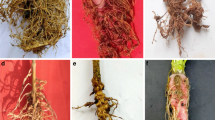Abstract
The biology of an undescribed weevil,Eutinobothrus sp., and its specificity toSida acuta, a serious weed in northern Australia, were studied in a quarantine facility in Australia. Sixty-eight plant species were screened and onlyS. acuta andS. rhombifolia could sustain populations ofEutinobothrus sp. Adults feed externally on the stems and oviposit in feeding scars. Larvae feed internally and pupate in the stem. Prepupae and pupae may aestivate in the stem and adults emerge with the onset of the wet season when new growth is evident.Eutinobothrus sp. was released in January, 1994 in the Northern Territory and has established.
Résumé
La biologie d'Eutinobothrus sp., charançon en cours de description, et sa spécificité vis-à-vis deSida acuta, mauvaise herbe qui pose problème en Australie du nord, ont été étudiées en conditions de quarantaine en Australie. Soixante-huit espèces de plante ont été testées et seulesS. acuta etS. rhombifolia ont pu servir de nourriture pour les populations d'Eutinobothrus sp. Les adultes se nourrissent sur les tiges et pondent dans les perforation laissées par les prises alimentaires. Les larves se nourrissent des tissus de la plante et la nymphe se forme dans la tige. La prénymphe et la nymphe peuvent passer la période estivale dans la tige et les adultes émergent au tout début de la saison humide quand débute une nouvelle croissance de la plante. Des lâchers d'Eutinobothrus sp. effectués en janvier 1994 dans le Territoire du Nord ont abouti à son acclimatation.
Similar content being viewed by others
References
Forno, I. W., Kassulke, R. C. &Harley, K. L. S. — 1992. Host specificity and aspects of the biology ofCalligrapha pantherina (Col.: Chrysomelidae), a biological control agent ofSida acuta [Malvaceae] andS. rhombifolia in Australia. —Entomophaga, 37, 409–417.
Fryxell, P. A. — 1987. Sidus Sidarum VII. The genusSida (Malvaceae) in Australia. —Sida, 12, 22–27.
Holm, L. G., Pluckett, D. L., Pancho, J. V. &Herberger, J. P. — 1977. The world's worst weeds: Distribution and biology. —The University Press of Hawaii, Honolulu, pp. 621.
Kleinschmidt, H. E. & Johnson, R. W. — 1977. Weeds of Queensland. —Queensland Department of Primary Industries, pp. 469.
Parsons, W. T. &Cuthbertson, E. G. — 1992. Noxious Weeds of Australia.Inkata Press, Melbourne, pp. 508–510.
Santos, W. J., Gutierrez, A. P. &Pizzamiglio, M. A. — 1989. Economic damage caused by the cotton stem borer in southern Brazil. —Presquisa Agropecuaria Brasileira, Brasilia. 24, 297–305.
Sturtz, J. D., Harrison, P. G. &Falvey, L. — 1975. Regional pasture development and associated problems II Northern Territory. —Tropical Grasslands, 9, 83–91.
Wibmer, G. J. &O'Brien, C. W. — 1986. Annotated Checklist of the Weevils (Curculionidaesensulato) of South America (Coleoptera: Curculionidae). —American Entomological Institute, Michigan, p. 225.
Author information
Authors and Affiliations
Rights and permissions
About this article
Cite this article
Day, M.D., Forno, I.W., Segura, R. et al. Life cycle and host specificity ofEutinobothrus sp. (Col.: curculionidae) an agent for biological control ofSida acuta (malvaceae) in the northern territory, Australia. Entomophaga 40, 345–355 (1995). https://doi.org/10.1007/BF02373722
Received:
Accepted:
Issue Date:
DOI: https://doi.org/10.1007/BF02373722




